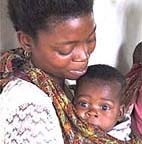|
||||

| |
|||
The human immunodeficiency virus (HIV) is the cause of acquired immune deficiency syndrome (AIDS). No other communicable disease is responsible for more adult deaths today. Last year, HIV killed a record 2.6 million people and has caused the deaths of some 16 million people since the epidemic began. Today, some 33 million people are living with HIV/AIDS, according to estimates by the Joint United Nations Programme on HIV/AIDS (UNAIDS) and the World Health Organization, and during 1999, some 5.6 million people became infected with the virus. The brunt of the disease burden globally has been borne by Sub-Saharan Africa, where some 70 per cent of all HIV-positive people live. However, infection has sharply increased in other regions including Eastern Europe and South Asia. HIV is spread by sexual contact, from mother to child during pregnancy, childbirth and through breast milk, and through infected blood and the use of shared needles. Effective drug treatments have become available for HIV in the 1990s in the industrialized countries. These drugs can significantly prolong life although they cannot be called cures. However, the high cost of these drugs puts them far beyond the reach of most people affected with HIV, who live in low-income countries. Vaccines for HIV remain an urgent need. Despite unprecedented research, however, no vaccine for HIV has yet been licensed although a number are in trials. For the most recent UNAIDS/WHO update on the
epidemic, dated June 2000, see: For updated information on HIV vaccine development
and links to other sites see: For information on HIV vaccines and related
news see: For new UNAIDS guidelines on the ethics of
HIV vaccine research, see:
|
|||
|
Contact GAVI | Guestbook | Text version | Credits and Copyright |
|||

